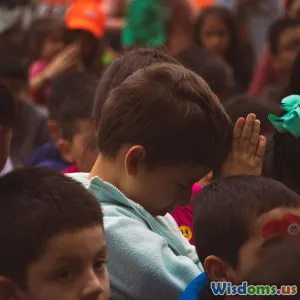
What Science Says About Collective Prayer Benefits
8 min read Explore scientific insights into collective prayer and its impact on health, psychology, and community well-being. (0 Reviews)
What Science Says About Collective Prayer Benefits
Prayer has been a cornerstone of human spirituality and community for millennia, transcending cultures, religions, and eras. But aside from its spiritual essence, could collective prayer hold tangible benefits grounded in science? In recent decades, researchers from psychology, neuroscience, and medicine have attempted to unravel the effects of praying together—exploring what happens when individuals unite their intentions, hopes, and meditations. This article dives deep into the latest empirical evidence illuminating collective prayer's influence on health, psychological states, and social dynamics.
Understanding Collective Prayer
Before dissecting scientific findings, it’s important to clarify what collective prayer entails. Unlike private or individual prayer, collective prayer involves groups of people coming together with shared purpose—whether in churches, synagogues, mosques, meditation circles, or even via digital platforms.
The essence isn’t only verbalizing petitions or gratitude—it’s about the synchronization of focus, emotions, and energy within a communal setting. This synergy creates a shared atmosphere that might promote physical and mental changes beyond individual levels.
Physiological Effects of Collective Prayer
Immunological and Cardiovascular Benefits
Multiple studies have highlighted physiological shifts coinciding with group prayer. A 2008 study published in the Journal of Behavioral Medicine showed that participants who engaged in collective meditation or prayer exhibited decreased cortisol (the stress hormone), leading to improved immune function. Chronic stress suppression through peaceful group prayer can enhance resistance to infections.
In addition, synchronized rhythmic chanting or praying, typical in group worship, affects heart rate variability (HRV). High HRV correlates with greater adaptability and cardiovascular health. Dr. Rollin McCraty and the HeartMath Institute found that group prayer and meditation sessions lead to heart rhythms syncing between participants, creating an entrainment effect that stabilizes blood pressure and reduces stress markers.
Neurological Changes
Brain imaging studies using functional MRI have observed increased activation in regions linked to attention and empathy during collective prayer. A 2016 study demonstrated that participants praying together showed enhanced activity in the prefrontal cortex, the area responsible for executive function, emotional regulation, and social cognition. This neural engagement likely fosters feelings of connectedness and compassion.
Moreover, collective prayer can boost dopamine levels—reward neurotransmitters—creating positive mood states. The combined mental focus of a group may amplify these neurochemical responses more than solitary prayer.
Psychological and Emotional Benefits
Enhanced Mood and Reduced Anxiety
Shared prayer sessions often induce states of calmness and positivity. A 2013 research article in Psychology of Religion and Spirituality found that individuals who participated in group prayer reported greater reductions in anxiety and depressive symptoms compared to those who prayed alone. The collective experience can imbue members with emotional support, fostering resilience.
Promotion of Empathy and Social Bonding
Science affirms that collective prayer supports empathy and prosocial behavior. Mirror neuron systems in the brain activate more robustly during synchronized group activity—for example, chanting together—thereby strengthening social attunement.
Psychologist Dr. Barbara Fredrickson discovered that shared spiritual practices, including prayer, release oxytocin, the “bonding hormone,” which fosters trust and forgiveness within communities. This hormone reinforces the emotional glue that keeps social groups healthy and cooperative.
Social Dynamics and Community Health
Building Community Cohesion
Collective prayer acts as a ritual that unites individuals, establishing a shared identity and purpose. Research into human social behavior shows rituals increase cooperation and reduce social anxiety.
Robert Putnam’s seminal work "Bowling Alone" discusses how communal rituals—including prayer groups—increase social capital, which is the network of relationships that facilitate cooperation in society. Communities with high social capital report better overall health and lower crime rates.
Collective Intention and Healing?
One of the more controversial but intriguing areas is whether collective prayer can influence healing outcomes beyond psychosomatic effects. The Study of the Therapeutic Effects of Intercessory Prayer (STEP) trial, published in 2006, investigated distant intercessory prayer effects on cardiac patients. While results were mixed and some methodological criticisms arose, the study stimulated robust discussion on measurable communal prayer effects.
More recent meta-analyses, such as the 2020 paper in The Journal of Religion and Health, concluded that collective prayer enhances patient well-being by improving mental states, which may influence recovery indirectly. Although direct physical changes from distant prayer remain scientifically elusive, the psychological pathways to healing are significantly supported.
Integrating Collective Prayer into Modern Wellness Practices
Recognizing the scientific evidence, many modern wellness programs integrate collective prayer or group meditation to capitalize on its benefits. Hospitals introduce prayer circles or chaplain-led group sessions to complement medical treatment, fostering holistic care.
Workplaces have also adopted group mindfulness and prayer sessions to enhance employee well-being and teamwork. For instance, a survey of IT companies practicing collective meditation showed a 20% improvement in team cohesion and a considerable reduction in reported stress levels.
Conclusion: Unlocking the Science Within Spiritual Unity
Science uncovers compelling evidence that collective prayer transcends spiritual ritual—it produces tangible physiological, psychological, and social advantages. From biochemical stress reduction and neural synchronization to community bonding and enhanced empathy, the benefits extend into multiple domains.
While certain claims—especially those about miraculous healing—require cautious interpretation, the convergence of modern science with age-old practices highlights that the power of collective prayer lies as much in human connection as it does in faith.
In a fast-paced, often fragmented world, embracing communal prayer traditions can promote tranquility, resilience, and togetherness, inspiring actionable pathways toward personal and societal health.
Embracing collective prayer could serve as a valuable complement to contemporary health frameworks, inviting us all to explore shared intentionality as a science-backed resource.
Rate the Post
User Reviews
Popular Posts



















